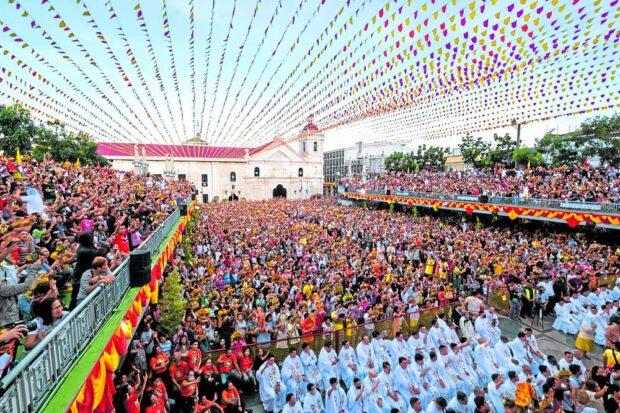In Cebu, Santo Niño devotees gather as feast of faith begins

OUTPOURINGOF FAITH People from all walks of life fill the Basilica Minore del Santo Niño de Cebu and its Pilgrim Center in downtown Cebu City during the first novenaMass in honor of the Holy Child Jesus on Thursday. —EMMANUELLE SAWIT
CEBU CITY — A sea of candles brightened a portion of Osmeña Boulevard here as at least 200,000 devotees joined the foot procession before the crack of dawn on Thursday that signaled the start of an 11-day festivity leading to Cebu’s biggest festival in honor of the Holy Child Jesus.
Devotees, young and old, carried their own images of the Santo Niño and lit candles as they prayed the holy rosary, and sang liturgical hymns during the two-kilometer procession called “Walk with Jesus.”
READ: Pit Senyor! Interesting facts about the Señor Sto. Niño
The prayer walk, which started at the Fuente Osmeña Circle at 4 a.m. ended at the Basilica Minore del Santo Niño de Cebu in downtown Cebu City about an hour later.
The flower-decked carroza (carriage) that carried the image of Santo Niño arrived at the basilica around 5 a.m. and was welcomed with shouts of “Viva Pit Señor!” and “Viva Señor Santo Niño!”
The image was then carried to the altar and the first of the novena Masses in honor of the feast of the Holy Child Jesus started.
The Fiesta Señor is the religious celebration held every third Sunday of January in honor of the Santo Niño or the Holy Child Jesus. Its cultural counterpart is the Sinulog Festival.
READ: Sto. Niño de Cebu image visits hospitals, jails
The Walk with Jesus and the first novena Mass kicked off the 11-day festivity that would culminate on Jan. 21 with a Pontifical Mass at the basilica and the Sinulog Grand Parade at the South Road Properties.
People look forward to the Sinulog Grand Parade, one of Cebu’s biggest crowd drawers featuring dance rituals that tell a story of how the pagans’ conversion to Christianity helped their lives. Aside from the dancing contingents, puppeteers, floats and “higantes” (giant paper-mache puppets) also take part in the parade.
‘Magnet of love’
In his homily during the novena Mass, Fr. Nelson Zerda, rector of the basilica, noted that all roads lead to the Basilica Minore del Santo Niño de Cebu every January.
“I believe this has something to do with our endearment to the Santo Niño,” he added. “How wonderful it is to behold what we see. A large crowd of people walking together with Jesus.”
The 3,500-capacity church courtyard was packed, with thousands more spilling into the streets outside of the basilica.
They watched the Eucharistic celebration through large LED screens and television monitors installed around the church complex.
The religious activities of the Sinulog Festival this year will focus on the theme, “Santo Niño: Magnet of love in the synodal Church.”
As part of tradition, the fiesta’s hermano and hermana mayores for 2024—renowned Sinulog dance choreographer and Santo Niño devotees Val Sandiego and wife Ofelia—were officially presented to the people during the Mass.
During the offertory, people waved their hands in the air in unison as they sang “Bato-Balani sa Gugma” (Magnet of Love), an ancient hymn in honor of the Sto. Niño.
At the end of the first novena Mass, Zerda carried the image of the Santo Niño and led people in dancing the traditional one-step-forward, two-steps-backward Sinulog dance for about five minutes.
The image of the Santo Niño was given as a baptismal gift by Portuguese explorer Ferdinand Magellan to Cebu’s Hara Humamay, who was later given the baptismal name, Queen Juana, in 1521.